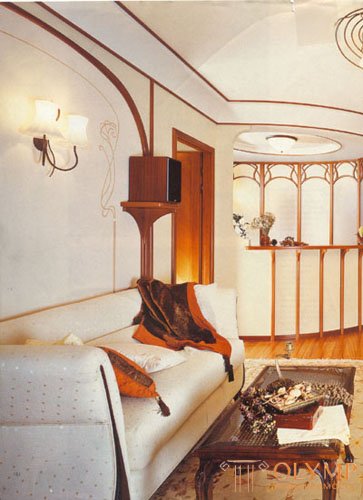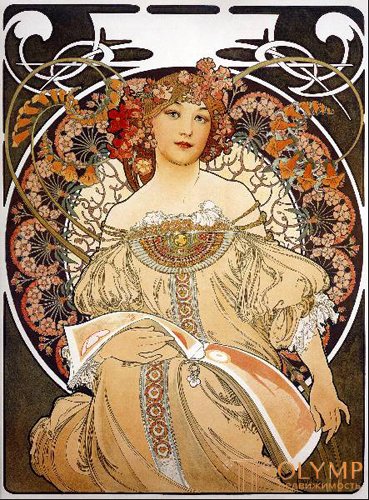
Art Nouveau Art Nouveau ( French L'Art Nouveau - New Art ) is the French name for the art of the Art Nouveau period at the turn of the 19th and 20th centuries. However, it is more correct to refer this term not as a whole to the art of modernity, including various trends and styles, but only to one of them - the “floreal”, or decorative-ornamental, current and style, originated in Belgium and France.
The slogan is “back to nature”.
Characteristic features are a wave-like curved line combining the spirit of the East and the desire for constructiveness. The whimsically curved lines of the decor visually blend into the elements of the building structure. In the decoration, much attention is paid to the stylized plant pattern, flexible fluid forms, which turned the metal structures into fancy thickets of fantastic colors.
The symbol of style is the sophisticated form of the cyclamen flower, “water” plants irises, lilies, algae. Stylized plant and animal forms with gently curved, moving lines, flat and not giving shadows, thanks to which, far from naturalism or historicism, they are most likely similar to late Gothic forms and Japanese painting.

Art Nouveau style in the interior, photo
The main elements of Art Nouveau, Art Nouveau:
Art Nouveau - emerged in the second half of the XIX century in Europe as uniting the various areas of advanced art, universal, proposed for universal introduction style.
Approximately in 1890, a movement was born in England that promoted a new aesthetics of art, which would soon cover all of Europe - the Art Nouveau style. His first steps were to ornament.
In 1856, the French painter, engraver and ceramist F. Brakmon first saw the Japanese colored woodcuts by K. Hokusai in the Delatre shop in Paris. They were wrapped in packs of Chinese tea. But very soon these unusual woodcuts attracted the attention of many French artists.
Post-impressionist painters found in them what they had been looking for a long time: the emancipation of the color spot, the decorativeness of the organization of the plane, the expressiveness of the silhouette, and whimsically wriggling contours. It is also characteristic that Paris was ready to accept these plastic qualities, because long before that they had been shaped by the whole evolution of European visual art. At the very beginning of the XIX century. English symbolist poet and artist William Blake was one of the first to “find” a curved line in his whimsical, fantastic watercolors and engravings.
On the basis of curved lines, the concept of a continuous “flowing” space is being developed, combining the utilitarian function of architectural structures, furniture, household items with their design, external decor and material processing technology. This innovative concept determined the integrity and integrity of the "new style".
The second center after France in Paris, Art Nouveau, was the Nancy School, headed by E. Halle, L. Majorelli and the Daum brothers. The Art Nouveau style is interesting in that the completely rational idea of harmony of function, construction and external form is combined in it with fantasy, whimsicalness, even mysticism, and therefore it can be considered one of the manifestations of Romanticism in the art of the turn of the XIX-XX centuries. (fig. 379, 383). But in the art of this period, which later received the more general name of Modernity, other currents existed alongside Art Nouveau: the national-romantic, geometric, neoclassical
The brand name for Art Nouveau was Hermann Obrist’s famous embroidery “Strike of the whip” on the curtain of 1895. Initially, the work was called “Alpine Violets”, but when a critic criticized the frantic movements of the plant's stem with the “furious twists of a collapsing scourge”, the term “blow scourge ”, which soon became the trademark stroke of the Art Nouveau style.
Vivid examples of Art Nouveau design are the interior work of the Belgians Victor Orta and Henry Van de Velde, the interiors and furniture of the fantastic houses of the Spaniard Antonio Gaudi, the interior design in the mansions of the architect F. Shechtel; lattices of the Paris subway and furniture by Hector Guimard, interiors, grilles and furniture in Munich by August Endel, Berhard Pancock; stained glass windows by Louis Comfort Tiffany; glass products and furniture by Eugène Halle, furniture by French furniture designers Louis Majorelle, Victor Prouvé, Eugene Wallen, Jacques Gruber, etc.
The definition of Art Nouveau, Art Nouveau (also called “Orta style”, Guimard style, metro style, modern style, Liberty style, English style), despite all its cosmopolitanism, had some characteristic features: the cult of the line and the organic power of plants and ornaments, symbolizing the structure, the emphasis on the national style of the country, underlined floral motif (France Belgium), linear decor or strict composition with complex symbolism.

Art Nouveau style in the interior, photo
The refusal of straight lines and angles in favor of a more natural smooth movement of curved lines became a stylistic feature of Art Nouveau. Art Nouveau style originality was based on the ornamental waviness of the lines of natural forms of flora and fauna. The Ar Nouveau lines often resemble dancing, wavy arabesques, imbued with organic energy and the vital force of plants.

Art Nouveau style in the interior, photo
The interior design in the Art Nouveau style is likely to be loved by nature lovers. Art Nouveau welcomes the interior, where all the elements seem to be natural, natural, and not made and invented by man. This is indicated by the rejection of straight lines and angles.

Art Nouveau style in the interior, photo
In the room, which is made in the Art Nouveau style, you will not even see the right angles of the rooms. They are shaded and rounded. The same can be said about the furniture. Art Nouveau prohibits the use of furniture with rough sharp edges, the furniture should be streamlined, semi-circular forms.

Art Nouveau style in the interior, photo
The "water" plants irises, lilies, algae can be considered the business card of Art Nouveau style. A picture with such colors will already create a certain atmosphere. A wavy line (“hit the whip”) can be used in the design of windows: make curtains not smooth at the edges, but wavy, and cut them at an angle. In addition, you can use a specific "triangular rose." This drawing is very characteristic of the Art Nouveau style. The flower can be embroidered, for example, on pillows. This author's work will certainly appreciate your guests.

Art Nouveau style in the interior, photo
In a big fashion were the images of women with incredibly long, flowing hair. Perfectly stylized bright and graceful insects and birds - dragonflies and butterflies, peacocks and swallows. The natural decorativeness of Art Nouveau contributed to its application in various genres. In the period of the highest popularity, it was used to decorate almost every imaginable handicraft and mass circulation, as well as the facades of buildings and the interior design of many shops, restaurants and private mansions.

Art Nouveau style in the interior, photo
Particular attention in the art nouveau style is given to color. The theme of water dictates to us and the shades that we choose. They must be in harmony with gold and silver (water glistens in the sun). “Swamp-colored” works well for gold: it is brown (almost black), dark green, light green (both warm). This combination can complement the blue of the peacock's tail (color "electric"). For silver, we apply the colors that we find in the poems of the silver age of Russia. Especially - the work of Alexander Blok. These are the colors of the mist: silver-purple, pinkish, blue, grayish and black.

Art Nouveau style in the interior, photo
In order to penetrate the mood of Art Nouveau, you also need the work of Czech artist Alphonse Mucha. Being a typical embodiment of the artistic search for the turn of the XIX - XX centuries, the “style of the Fly” became a model for a whole generation of graphic artists and designers.

Art Nouveau style in the interior, photo
His omen became an idealized, stylized figure of a beautiful, girlishly graceful woman, freely but indissolubly inscribed in an ornamental system of flowers and leaves, symbols and arabesques. Since this motif was one of the most widely used in painting at the end of the century, the “Fly style” was for some time considered a synonym for the Art Nouveau movement as a whole.
The interior in the style of Art Nouveau is a harmonious combination of the most diverse materials and methods of decoration - this is metal and stone, wood and glass, wallpaper and painting, stained glass and mirrors.

Art Nouveau style in the interior, photo
Making the room in the style of art nouveau, be guided, above all, decorative. All the details of the interior should be a kind of natural creation, which was not touched by the human hand. Straight lines are irrelevant here; give preference to wavy semicircular lines. Wallpaper in this interior can be used with different textures. Moldings can be white. Soft floral motifs will give the living room, bedroom some warmth and comfort. Lamps, both desktop and wall, it is better to use frosted glass. To the place will be ornaments made of flowers. Local light is better to use a bit muffled. Textiles should capture the area of the entire wall on which the window is located. Curtains should be up to the floor, decorated with rich drapery.
Art Nouveau, Art Nouveau - style as a decorative and ornamental trend of modernity.
Art Nouveau - the most beautiful and popular style. However, when embodied in the interior, it requires a depth of understanding of both the designer and the customer. It can be said, the most modern style (its variations today are presented through high-tech).
Art nouveau style is usually preferred by unmarried young girls and married couples. Its soft lines and the extraordinary smoothness of its outlines underline a certain femininity, elegance and tenderness of its owners.
Что бы оставить комментарий войдите
Комментарии (0)